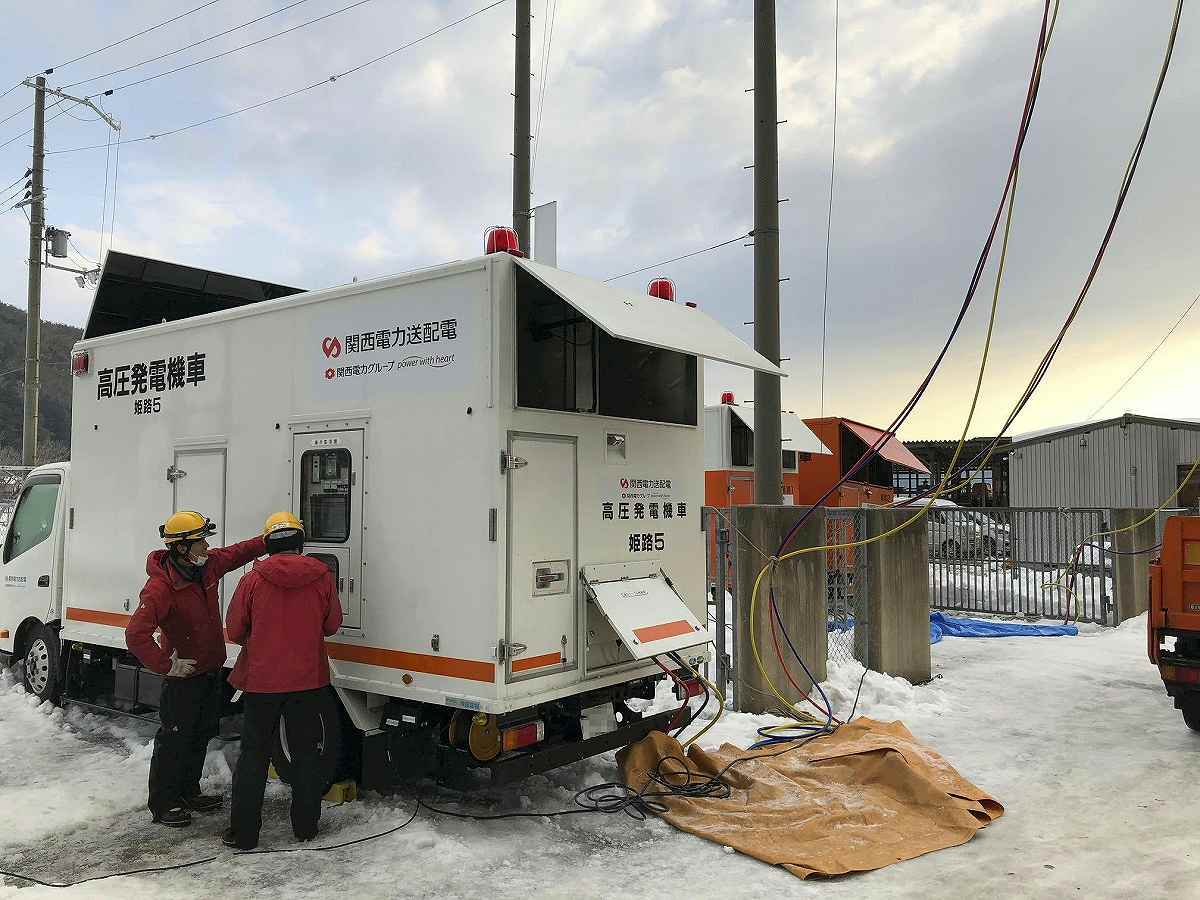
A high-voltage generator provides electricity in Toyooka, Hyogo Prefecture, on Wednesday. (The image has been partially corrected.)
11:09 JST, January 16, 2021
Power stability has been walking a tightrope particularly in western Japan following severe cold weather since late last year as well as heavy snow on the Sea of Japan coast.
Demand for electricity has exceeded estimates because of a sharp increase in the use of heaters. This was compounded by a spate of miscalculations, such as a decline in solar power generation due to snowfall and fuel shortages for generating thermal power, Japan’s main source. Sluggish moves to restart nuclear power plants as a mainstay source of stable supply served as another factor.
■ Power-supply car
Snow and sleet covered the lowland of the Kinki region Tuesday when business activities resumed after the three-day holiday weekend. At Kansai Electric Power Co., the power consumption rate, which is the percentage of electricity consumption against the utilities’ supply capacity, reached 99% between 8 a.m. and 9 a.m. After 10 a.m., demand exceeded 25.9 million kilowatts, exceeding the maximum January demand of 25.55 million kilowatts that was estimated last autumn.
In KEPCO’s service area, electricity was supplied by Tokyo Electric Power Company Holdings Inc., Chubu Electric Power Co. among other power companies, while KEPCO dispatched 31 high-voltage generators that are usually mobilized in the event of a disaster.
After the Great East Japan Earthquake, Kyushu Electric Power Co. introduced a system to purchase electricity from households at relatively high prices, leading to a rapid increase in solar power generation in its service area. As a result of snowfall, electricity from sunlight accounts for up to half of the company’s daytime power source. Snowfall this winter has dropped the company’s available power by 30% to 40%, forcing the company to secure other sources of electricity.
The cold spell since the end of last year has hit electricity supplies in the other areas, too. On Jan. 8, electricity demand in seven regions nationwide, except Hokkaido, the Kanto region and Okinawa Prefecture, exceeded the level expected “once in 10 years.” The reserve capacity fell below 3%, or a benchmark to supply power stably, across the board.
■ Difficulty in procuring
Many power companies usually supply the most electricity in the summer, when the use of air conditioning soars. They therefore conduct regular inspections on thermal power plants in winter in preparation for summer demand, meaning that not all power plants are in a standby state capable of generating electricity immediately in the winter.
The tight power supply this time has led to concerns about fuel shortages in thermal power generation, which is designed to make up for power shortages.
Liquefied natural gas (LNG) stocks, the main thermal fuel, decreased due to a larger-than-expected increase in thermal power generation. Most of the LNG is imported from abroad. Since the gas vaporizes, its domestic stocks have been kept small at a two-week supply.
Power companies are trying to procure LNG additionally, but the surge of the novel coronavirus caused tanker operations to stall, making it difficult to procure, which usually takes about two months to receive. Competition to secure fuel with China and South Korea, which have been hit by a cold spell like Japan, is also accelerating the delay in procurements.
■ Dependence on thermal
Since the Great East Japan Earthquake, restarts of nuclear power plants have been slow, contributing to the current electricity shortage.
Of the 33 nuclear reactors in Japan, only three are currently generating electricity. In fiscal 2019, nuclear power accounted for only 6% of all power generation, down from 25% before the disaster.
Nuclear power, which has been a stable mainstay power source with low generation costs, has been shunned, and 76% of that former supply now comes from thermal power. KEPCO restarted its No. 4 reactor at its Oi nuclear power plant on Friday to stabilize its power supply.
In the wake of the March 11, 2011, nuclear accident at TEPCO’s Fukushima No. 1 nuclear power plant, strict safety standards were imposed on the reactors’ operations. The Nuclear Regulation Authority, which was established after the accident, asked power companies and other entities to comply with new regulatory standards to prepare for major accidents. As a result, no reactors were in operation at one point.
The law stipulates that nuclear power plants can operate for 40 years in principle. The government has not made clear its policy on the construction of new facilities.
"Business" POPULAR ARTICLE
-

Tokyo Economic Security Forum to Hold Inaugural Meeting Amid Tense Global Environment
-

Keidanren Chairman Yoshinobu Tsutsui Visits Kashiwazaki-Kariwa Nuclear Power Plant; Inspects New Emergency Safety System
-

Imports of Rare Earths from China Facing Delays, May Be Caused by Deterioration of Japan-China Relations
-

University of Tokyo Professor Discusses Japanese Economic Security in Interview Ahead of Forum
-

Japan Pulls out of Vietnam Nuclear Project, Complicating Hanoi’s Power Plans
JN ACCESS RANKING
-

Tokyo Economic Security Forum to Hold Inaugural Meeting Amid Tense Global Environment
-

Keidanren Chairman Yoshinobu Tsutsui Visits Kashiwazaki-Kariwa Nuclear Power Plant; Inspects New Emergency Safety System
-

Imports of Rare Earths from China Facing Delays, May Be Caused by Deterioration of Japan-China Relations
-

University of Tokyo Professor Discusses Japanese Economic Security in Interview Ahead of Forum
-

Japan Pulls out of Vietnam Nuclear Project, Complicating Hanoi’s Power Plans



























